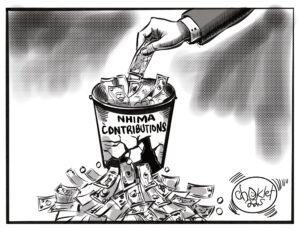UNIVERSITY of Zambia Vice-Chancellor Professor Luke Mumba says the institution has produced a restructuring plan which will entail downsizing the number of employees from 2,200 to 1,300 over a period of four to five years.
During a state of the institution address, Wednesday, Prof Mumba who lamented UNZA’s K4.4 billion kwacha debt, attributed the university’s high operational costs to its staff.
“The total UNZA debt now stands at K4.4 billion. On its part, management has produced a restructuring plan which will entail a rightsizing the number of employees from 2,200 to 1,300. This will be a 40 percent reduction in staffing. Since to achieve this we require funding, we shall do it in a phased manner, mostly relying on natural staff attrition and this will be done over four to five years. The above notwithstanding, I appeal to government to increase the grant so that it meets most, if not all of our payroll obligations,” he said.
“One of the key drivers in the high operational costs are the UNZA staff costs which account for 80 to 90 percent of the total expenses incurred by the University of Zambia. Arising from funding gaps, the University of Zambia has been exposed to intermittent delayed payment of salaries. Further, the University of Zambia has fallen behind in the remittance of statutory obligations and settlement of retirement and contract gratuities. Moreover, the University of Zambia has fallen behind in paying providers of utilities resulting in a myriad of litigation which are also very costly to the institution.”
He said the university had frozen recruitment of new staff except for scarce and critical skills, and only under special circumstances.
“In order to ensure UNZA’s organization structure is aligned to its strategy, an organization structure review was undertaken. The new structure awaits approval of the caretaker committee. Once implemented, it is anticipated that the overall staff establishment will be reduced from the current 2200 employees to 1300. This decision will ensure that UNZA is transformed into a financially sustainable institution. When implemented, the proposed structure will reduce the payroll costs from the current K612.71 million per annum to K445.41 million per annum, representing a 27 percent reduction in the payroll costs,” Prof Mumba said.
He further said the University of Zambia had implemented the decision not to engage any part-time lecturers, tutors and staff development fellows unless all the full-time academic staff were optimally utilized through the prescribed minimum teaching workload.
Prof Mumba said to help cushion the retirement liabilities and outstanding contractual obligations, government last month gave the institution a K150 million bond and a K50 million loan with K75 million disbursed so far.
“Another key component in the huge university debt are the retirement liabilities and outstanding contractual obligations. As at 31st December 2020, the University of Zambia was owing in excess of k600 million in retirement liabilities. Arising from the requirement of the law to keep retired persons on the payroll, the university overheads have increased further. I am glad to report that in February 2021, the University of Zambia successfully secured government support with a bond of k150 million and a loan of K50 million both from Zanaco. So far, only k75 million has been disbursed. Once the full amount is disbursed, we plan to settle some of the outstanding retirement and contract obligations with the following impact: retirees removed from the payroll,126; benefits for staff – dismissed/resigned/medical cases, 147; gratuities for currently serving staff, 612; Total, 885. Annual planned savings from retiree monthly salaries is expected to be K22.5 million,” he said
“This loan however still falls short of the k400 million required to clear the entire burden. We continue to look to the government to intervene and explore available resources to allocate at least k400 million to clear the retirement liabilities which are historical in nature. The government approved financial sustainability framework 2021 to 2025 promises to sort out this challenge.”
He called for an increase in the government grant to the institution as it currently has an annual deficit of K800 million and will cease to exist with support from government.
“The University of Zambia has worked hard to marginally increase other sources of funding in the period 2016 to-date. Therefore, the challenge is significantly a marginal increase of funding from the government. Arising from this, the university statement of comprehensive income has over the period 2014 – 2017 recorded a consistently rising deficit. The average annual deficit of the University of Zambia now stands at k800 million. Today, the institution is technically insolvent as indicated by external audits for the past five years, meaning that without government support, UNZA cannot continue to exist,” Prof Mumba said.
“The University of Zambia is faced with significant financial challenges. While the government grant has remained static, its real value has declined with a continued rise in the operational costs.”
And Prof Mumba said the university had procured live virtual classroom equipment costing US$658,000, to support the ICT use in the provision of open and distance learning.
“With regards to our investment in virtual infrastructure, the University of Zambia internet bandwidth has been increased from 300mbps to 512mbps. The internet bandwidth increment has tremendously speeded up online student registration and provided sufficient capacity for access to online educational content and libraries to which the university subscribes. The University of Zambia has also procured live virtual classroom equipment costing US$658,000, to support the ICT use in the provision of open and distance learning. This equipment is now in use,” he disclosed.
He added that the K11 million compensation from the Lusaka decongestion project had enabled the institution to commence the construction of a three kilometer perimeter wall fence for security purposes.
“The University of Zambia faces numerous security challenges attributed largely to the porous nature of the great east road and ridgeway campuses. We are grateful to the president of the republic of Zambia H.E. Dr Edgar Chagwa Lungu for facilitating the release of the compensation of K11 million by the Ministry of Local Government and Housing for university land taken over in the Lusaka decongestion project. Arising from this, the University of Zambia (UNZA) has commenced the construction of the 3 km perimeter wall fence aimed at securing the institution from vandals and theft activities. Once completed, the wall fence will enhance the outlook of the university but will also improve the security of the infrastructure as well as the community living and working within the institution,” said Prof Mumba.
Meanwhile, Prof Mumba revealed that since the Presidential directive, 60 illegal occupants of student rooms have been evicted with some handed over to the police for receiving money from unsuspecting students.
And the Vice Chancellor said that the introduction of direct entry into all the schools has attracted an increased level of student enrolments with over 11,000 school leavers given provisional acceptance and of this number, close to 5,000 have registered so far.
He, however, made a plea to parents and sponsors of registered students to ensure they settle fees in time as writing exams on credit will no longer be allowed.
























